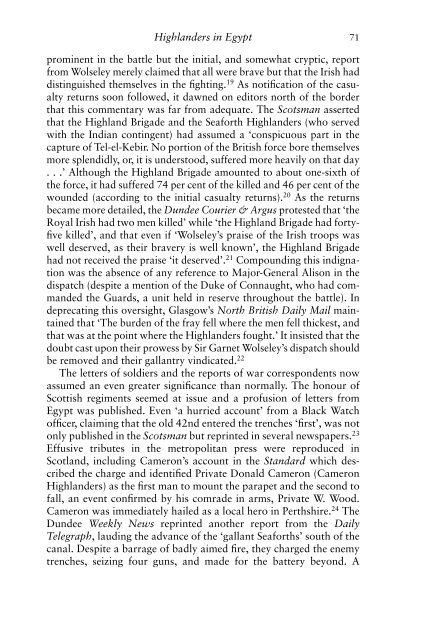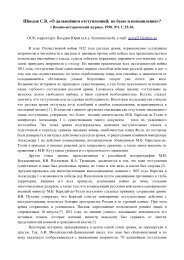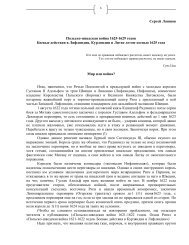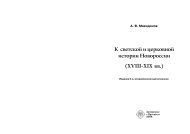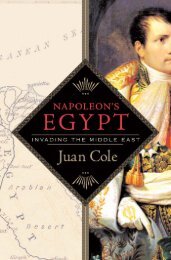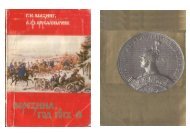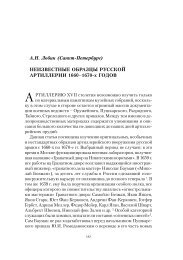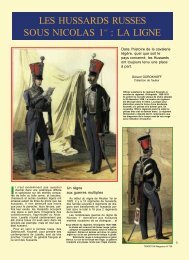The Scottish soldier and Empire, 1854-1902 - Reenactor.ru
The Scottish soldier and Empire, 1854-1902 - Reenactor.ru
The Scottish soldier and Empire, 1854-1902 - Reenactor.ru
You also want an ePaper? Increase the reach of your titles
YUMPU automatically turns print PDFs into web optimized ePapers that Google loves.
Highl<strong>and</strong>ers in Egypt 71<br />
prominent in the battle but the initial, <strong>and</strong> somewhat cryptic, report<br />
from Wolseley merely claimed that all were brave but that the Irish had<br />
distinguished themselves in the fighting. 19 As notification of the casualty<br />
returns soon followed, it dawned on editors north of the border<br />
that this commentary was far from adequate. <strong>The</strong> Scotsman asserted<br />
that the Highl<strong>and</strong> Brigade <strong>and</strong> the Seaforth Highl<strong>and</strong>ers (who served<br />
with the Indian contingent) had assumed a ‘conspicuous part in the<br />
capture of Tel-el-Kebir. No portion of the British force bore themselves<br />
more splendidly, or, it is understood, suffered more heavily on that day<br />
...’ Although the Highl<strong>and</strong> Brigade amounted to about one-sixth of<br />
the force, it had suffered 74 per cent of the killed <strong>and</strong> 46 per cent of the<br />
wounded (according to the initial casualty returns). 20 As the returns<br />
became more detailed, the Dundee Courier & Argus protested that ‘the<br />
Royal Irish had two men killed’ while ‘the Highl<strong>and</strong> Brigade had fortyfive<br />
killed’, <strong>and</strong> that even if ‘Wolseley’s praise of the Irish troops was<br />
well deserved, as their bravery is well known’, the Highl<strong>and</strong> Brigade<br />
had not received the praise ‘it deserved’. 21 Compounding this indignation<br />
was the absence of any reference to Major-General Alison in the<br />
dispatch (despite a mention of the Duke of Connaught, who had comm<strong>and</strong>ed<br />
the Guards, a unit held in reserve throughout the battle). In<br />
deprecating this oversight, Glasgow’s North British Daily Mail maintained<br />
that ‘<strong>The</strong> burden of the fray fell where the men fell thickest, <strong>and</strong><br />
that was at the point where the Highl<strong>and</strong>ers fought.’ It insisted that the<br />
doubt cast upon their prowess by Sir Garnet Wolseley’s dispatch should<br />
be removed <strong>and</strong> their gallantry vindicated. 22<br />
<strong>The</strong> letters of <strong>soldier</strong>s <strong>and</strong> the reports of war correspondents now<br />
assumed an even greater significance than normally. <strong>The</strong> honour of<br />
<strong>Scottish</strong> regiments seemed at issue <strong>and</strong> a profusion of letters from<br />
Egypt was published. Even ‘a hurried account’ from a Black Watch<br />
officer, claiming that the old 42nd entered the trenches ‘first’, was not<br />
only published in the Scotsman but reprinted in several newspapers. 23<br />
Effusive tributes in the metropolitan press were reproduced in<br />
Scotl<strong>and</strong>, including Cameron’s account in the St<strong>and</strong>ard which described<br />
the charge <strong>and</strong> identified Private Donald Cameron (Cameron<br />
Highl<strong>and</strong>ers) as the first man to mount the parapet <strong>and</strong> the second to<br />
fall, an event confirmed by his comrade in arms, Private W. Wood.<br />
Cameron was immediately hailed as a local hero in Perthshire. 24 <strong>The</strong><br />
Dundee Weekly News reprinted another report from the Daily<br />
Telegraph, lauding the advance of the ‘gallant Seaforths’ south of the<br />
canal. Despite a barrage of badly aimed fire, they charged the enemy<br />
trenches, seizing four guns, <strong>and</strong> made for the battery beyond. A


